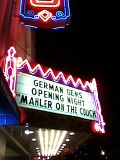 The 100-seat screening room upstairs at the YBCA was full yesterday afternoon for this 75 minute program of around 50 commercials & public service ads from Britain. Humor & high concept seem to be what the selections are mostly about. Frequently you sit through the commercial without finding out who the sponsor is until the very end. A slapstick film about a jockey who loses his horse turns out to be for Weetabix. A CGI extravaganza depicting rugged men turning deserts into lush, life-filled landscapes seems to have an environmental message, but it's advertising Guinness.
The 100-seat screening room upstairs at the YBCA was full yesterday afternoon for this 75 minute program of around 50 commercials & public service ads from Britain. Humor & high concept seem to be what the selections are mostly about. Frequently you sit through the commercial without finding out who the sponsor is until the very end. A slapstick film about a jockey who loses his horse turns out to be for Weetabix. A CGI extravaganza depicting rugged men turning deserts into lush, life-filled landscapes seems to have an environmental message, but it's advertising Guinness.Many of the ads are elaborate stunts. One unbelievably quirky ad documents shepherds attaching colored LEDs to their sheep & using them as pixels to simulate a pong game, the Mona Lisa & a fireworks display. It actually caused our audience to applaud. In a Johnny Walker ad, an actor talks to us as he strides purposefully through a mountain landscape in a single tracking shot, while relevant objects come into view at just the right moments in his narration. I found it nerve-wracking. Curiously, the best commercial award went to a T-Mobile ad featuring a flash mob dancing in Liverpool Street Station, which is not a very original concept. Many of the award-winning ads can be viewed on the BTAA Web site.
§ British Television Advertising Awards 2010
January 30, 2011 2:00 pm
Screening Room
Yerba Buena Center for the Arts











